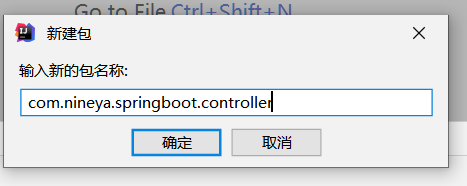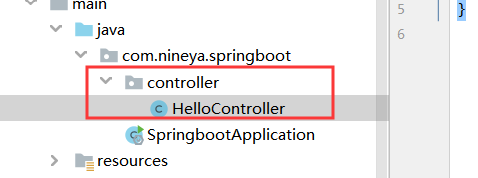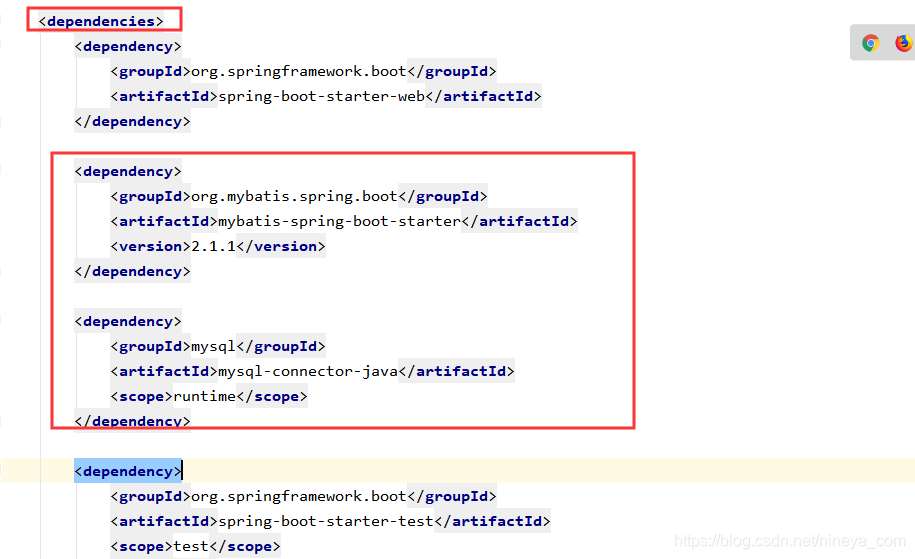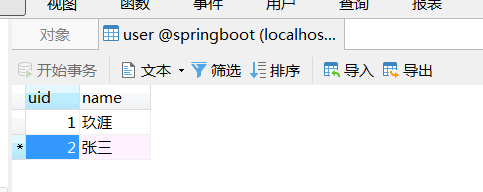写在前面
本文主要描述了如何使用IntelliJ,从零开始搭建一个springboot+mybatis+mysql项目。文章可能还有很多不足,请大家谅解,欢迎大佬提意见。
本文使用的东西
- IntelliJ 2019
- springboot
- mybatis
- mysql
1.新建项目
1.打开IntelliJ,选择“Spring Initializr”,点击下一步。

2.项目的type固定为“Maven Project”,其他的包名等可以根据现实情况改动。

3.添加依赖,点击“web”选中“spring web”添加该依赖,这个是我们web项目的基础。实际上还要添加MyBatis和mysql的依赖,我们稍后添加。点击下一步之后,直接点击“完成”,完成项目创建。创建项目要等待一小段时间,等待依赖下载添加完成。

4.项目创建好之后直接点击右上角的三角形运行。


5.打来浏览器,输入“http://localhost:8080”,出现如下图,表示项目搭建成功了,但是我们的项目还没有页面。

2.添加页面
2.添加一个“controller”包,该包用于存放控制器。

2.在“controller”包中新建一个“HelloController”的类。

3.使用“@Controller”将新建的“HelloController”类注释为控制器。

4.添加“hello”方法,使用“@RequestMapping("/hello")”注释使其监听到“hello”的请求,使用“@ResponseBody”注释返回字符串内容,不会用字符串查找jsp页面或者html页面。

5.点击右上角红色正方形停止运行,再点击三角形从新启动,打来浏览器输入“http://localhost:8080/hello”,可以看到我们return的字符串。

3.搭建mvc框架
3.1添加依赖
1.在pom.xml的project标签中加入以下内容,配置阿里云代理仓库
<repositories>
<repository>
<id>maven-ali</id>
<url>http://maven.aliyun.com/nexus/content/repositories/central</url>
<releases>
<enabled>true</enabled>
</releases>
<snapshots>
<enabled>true</enabled>
<updatePolicy>always</updatePolicy>
<checksumPolicy>fail</checksumPolicy>
</snapshots>
</repository>
</repositories>

2.添加依赖,在pom.xml文件的“dependencies”标签下加入下面两个依赖。
<dependency>
<groupId>org.mybatis.spring.boot</groupId>
<artifactId>mybatis-spring-boot-starter</artifactId>
<version>2.1.1</version>
</dependency>
<dependency>
<groupId>mysql</groupId>
<artifactId>mysql-connector-java</artifactId>
<scope>runtime</scope>
</dependency>

3.2 新建数据库
在mysql中新建一个“springboot””数据库“user”表,表中包含“uid”和“name”两个字段,随便插入几条数据,等一下用于测试。


3.3 搭建MVC框架
1.在项目中新建以下包和文件

2.文件内容为
“controller”包的“HelloController”接口:
package com.nineya.springboot.controller;
import com.nineya.springboot.entity.User;
import com.nineya.springboot.service.HelloService;
import org.springframework.beans.factory.annotation.Autowired;
import org.springframework.beans.factory.annotation.Qualifier;
import org.springframework.stereotype.Controller;
import org.springframework.web.bind.annotation.RequestMapping;
import org.springframework.web.bind.annotation.ResponseBody;
@Controller
public class HelloController {
@Autowired
@Qualifier("impl1") //取得bean,指定bean名称为impl1
private HelloService helloService;
@ResponseBody
@RequestMapping("/hello") //监听hello请求
public String hello(){
User user=helloService.getUser(1); //从Service取得uid为1的数据
return "hello "+user.getName()+", uid="+user.getUid()+".";
}
}
“entity”包的“User”类:
package com.nineya.springboot.entity;
//用户的实体类
public class User {
private long uid;
private String name;
public User() {
}
public User(long uid, String name) {
this.uid = uid;
this.name = name;
}
public long getUid() {
return uid;
}
public void setUid(long uid) {
this.uid = uid;
}
public String getName() {
return name;
}
public void setName(String name) {
this.name = name;
}
@Override
public String toString() {
return "User{" +
"uid=" + uid +
", name='" + name + '\'' +
'}';
}
}
“service”包的“HelloService”接口:
package com.nineya.springboot.service;
import com.nineya.springboot.entity.User;
//服务接口
public interface HelloService {
User getUser(long uid); //通过uid取得用户名称
}
“service.impl”包的“HelloServiceImpl”类,继承“HelloService”接口:
package com.nineya.springboot.service.impl;
import com.nineya.springboot.mapper.UserMapper;
import com.nineya.springboot.entity.User;
import com.nineya.springboot.service.HelloService;
import org.springframework.beans.factory.annotation.Autowired;
import org.springframework.stereotype.Service;
@Service("impl1") //注释为服务,指定bean名称为impl1
public class HelloServiceImpl implements HelloService {
@Autowired
private UserMapper userMapper;
@Override
public User getUser(long uid) {
return userMapper.getUser(uid);
}
}
“mapper”包的“UserMapper”接口:
package com.nineya.springboot.mapper;
import com.nineya.springboot.entity.User;
import org.apache.ibatis.annotations.Mapper;
@Mapper //注释为Mapper
public interface UserMapper {
User getUser(long uid);
}
“SpringbootApplication”类添加扫描Mapper接口
package com.nineya.springboot;
import org.mybatis.spring.annotation.MapperScan;
import org.springframework.boot.SpringApplication;
import org.springframework.boot.autoconfigure.SpringBootApplication;
@MapperScan("com.nineya.springboot.mapper")//使用MapperScan批量扫描所有的Mapper接口
@SpringBootApplication
public class SpringbootApplication {
public static void main(String[] args) {
SpringApplication.run(SpringbootApplication.class, args);
}
}
“resources”的“mapper”下的“UserMapper.xml”文件:
<?xml version="1.0" encoding="UTF-8" ?>
<!DOCTYPE mapper PUBLIC "-//mybatis.org//DTD Mapper 3.0//EN" "http://mybatis.org/dtd/mybatis-3-mapper.dtd" >
<mapper namespace="com.nineya.springboot.mapper.UserMapper">
<!-- application.yml中type-aliases-package:未配置则需要用全名-->
<select id="getUser" resultType="User">
SELECT * FROM user where uid=#{0}
</select>
</mapper>
“resources”目录下的“application.yml”文件:
server:
port: 8080 #配置本服务器的端口为8080
spring:
#数据库连接配置
datasource:
driver-class-name: com.mysql.cj.jdbc.Driver
url: jdbc:mysql://192.168.138.39:3306/springboot?useSSL=false&serverTimezone=CST&allowMultiQueries=true
username: root
password: 361654768
#mybatis的相关配置
mybatis:
#mapper配置文件
mapper-locations: classpath:mapper/*.xml
type-aliases-package: com.nineya.springboot.entity
#开启驼峰命名
configuration:
map-underscore-to-camel-case: true
3.4运行结果
成功取得数据库数据。

3.5项目源代码
我把项目源代码打包放在了百度网盘,需要的话点击链接前往下载》》Demo项目下载地址
提取码:kzaa
4.总结
本文只是简单描述了springboot+mybatis+mysql项目搭建,有不清楚的地方欢迎评论留言,看到的我都会回复的。本文到此结束,有什么不足的地方请大家不吝指正。
